




You can’t talk about Tuscan cuisine without mentioning pane sciocco, or unsalted bread. It has a crunchy crust, slightly golden color and a soft, dense inside.
It takes a while to get used to, but for those accustomed to it from birth, who since nursery school have been served an afternoon snack with prosciutto, tomato marmalade, or simply oil and salt—this is bread. The reasons for its being made without salt at times border on legend: one version points to the high tax Pisa placed on salt, to which Florentines responded by starting to make bread without it. But perhaps there’s a simpler explanation. If you’ve ever tasted a well cured prosciutto crudo or aged pecorino cheese, you’ll have noticed that these items need a bread that can balance out intense saltiness.
That’s why the first recipe in this Tuscan cookbook is one for unsalted bread. Others will follow, of course, such as Lunigiana chestnut flour bread and potato bread from Garfagnana, but this bread is the most important. It helps us to understand the Tuscan character and the character of our cooking. What’s more, it allows us, when turning to the pages where pappa al pomodoro and panzanella are found, to successfully recreate these recipes, having all the ingredients at hand - including this most important one.

Tuscan bread is made from a few essential ingredients: flour, yeast, and water. A strong flour is needed for the biga, a pre-ferment commonly used in Italian baking that must ripen for about twenty hours to give the bread the aroma that makes it so special. For the bread dough, on the other hand, a weaker flour is used to give the loaf its characteristic texture, crunchy crust and rather dense inside. When this bread turns stale, it will be soaked in water and used to make panzanella or pappa al pomodoro, and it’s the weaker flour used in the dough that allows the bread to come back to life, to be softened and then crumbled into a large heap.
Ingredients for 4 people
For the biga
300 grams strong flour
150 grams water, room temperature
4 grams fresh baker’s yeast
For the dough
400 grams of biga
1 kg type ‘0’ flour
600 ml tepid water
2 g fresh baker’s yeast (optional) extra virgin olive oil
Make the biga the day before. In a medium-sized bowl, dissolve the yeast in the room temperature water and add the flour. Briskly mix the ingredients until combined, then cover the bowl with plastic wrap. Let the dough ripen at room temperature for 20 to 24 hours.
For the dough, start by dissolving the yeast in half the water. If you have time, you can leave out the yeast and instead extend the rising time.
Combine the biga, flour, water, and yeast in a stand mixer bowl. Knead with the dough hook on high and gradually add the rest of the water, continuing until a smooth, uniform, elastic dough forms. Do not knead for more than 15 minutes.
Let the dough rest for about a half hour in a bowl greased with olive oil, then divide the dough into 4 parts of 500 grams each. Form each portion of dough into a loaf, keeping the ends slightly narrower. Transfer the loaves to a well-floured tea towel, with the towel closed on the underside, and let rest at room temperature, away from drafts. Let the loaves double in size. Heat the oven to 200° C / 392° F. Gently turn out the loaves onto a baking sheet covered with baking paper or onto a baking stone. Bake for around 45 minutes or until the loaves are golden and make a hollow sound when tapped on the bottom.

In the fall, these crepes are nice filled with roasted pumpkin, ricotta and nutmeg, or with a mixture of porcini mushrooms and calamint. In the spring, try a filling of asparagus or peas along with some ricotta and sautéed pancetta.The traditional ricotta and spinach filling seasoned with the everimportant nutmeg—said to be so dear to Caterina de’ Medici—simply cannot be outdone. For a rustic touch, use whole wheat flour and plenty of pecorino cheese.
Ingredients for 4 people
For the crepes
3 eggs
3 level tablespoons of whole wheat flour
1 pinch of salt
250 ml whole milk
For the filling
400 g fresh spinach
1 tablespoon extra virgin olive oil
1 garlic clove
250 g fresh sheep’s milk ricotta
100 g aged Tuscan pecorino cheese, grated
150 g medium-aged Tuscan pecorino cheese, cubed
1 pinch of salt
grated nutmeg
1 egg
For the béschamel sauce
50 g butter
60 g whole wheat flour
500 ml milk
1 pinch of salt
grated nutmeg
To garnish
grated pecorino
tomato sauce
extra virgin olive oil
Make the crepes at least a half hour prior. Beat the eggs together with the salt and whole wheat flour, being sure to dissolve all the lumps. Slowly pour in the milk and blend well.
For the filling, blanch the spinach for 5 minutes, drain and squeeze well to remove excess liquid. Finely chop the cooked spinach. Sauté the spinach for a few minutes in a tablespoon of oil and the garlic clove. Transfer to a bowl and add the ricotta, the grated and cubed pecorino, the nutmeg and salt.
Combine and taste. Add the beaten egg.
Make the béchamel by first melting the butter in a saucepan. When the butter has melted, add the flour and combine with a whisk for a few minutes until it starts to just turn brown in color and loses its raw aroma.
Slowly pour in the cold milk while mixing continuously to prevent lumps. Let the sauce cook for a few minutes until it thickens, then adjust for salt and nutmeg.
Heat a greased crepe pan (14-15 centimeters or 6 inches in diameter) and cook the crepes on medium heat for a few minutes on each side, or until golden.
Spread some of the creamed spinach and ricotta mixture on each and roll into a tube shape, as if making cannelloni. Lightly cover the bottom of a glass casserole dish with some of the béchamel then arrange the crepes in the dish.
Cover the crepes with the remaining béchamel, a few tablespoons of tomato sauce, more grated pecorino and a drizzle of olive oil. Bake at 200° C / 392° F for around 20 minutes, or until the crepes turn golden on the surface and the béchamel and cheese start to bubble on the sides. Serve warm, just out of the oven. Any leftovers can be warmed up (add a small amount of milk).

Browsing the stalls at Sant’Ambrogio market, just before the colors of the fruit begin to change to orange with the arrival of all the citrus fruits, crates of apples and pears fill the air with their autumnal aromas.
Usually the first dessert to come to mind here is apple cake, the classic version known since childhood. Not long ago I began to reconsider the pear, however, with its grainy and metallic taste and unique texture when cooked. I’ll often pair them with cinnamon, fresh ginger, wine or, better still, chocolate.
Ingredients for 8 people
For the pastry
150 grams butter, room temperature
150 g sugar
1 egg
300 g type ‘0’ flour
1 pinch of salt
zest of 1 lemon (organic, not chemically treated)
For the semolina and pear cream
500 ml whole milk
125 g semolina flour
2 eggs
6 tablespoons sugar
5 tablespoons vinsanto
2 ripe pears, peeled and cubed
For the chocolate ganache
250 ml whipping cream
250 g dark chocolate
cut into small pieces
Combine the butter and sugar until smooth, making sure no chunks of butter remain.
Add the egg and beat. Sift in the flour and salt and combine, followed by the lemon zest.
Work the dough quickly as to not let the butter warm, lightly press it down and cover with plastic wrap. Keep in the refrigerator for a few hours or overnight. Next make the semolina cream. Warm the milk and sprinkle in the semolina, making sure no lumps form. Whisk continuously. When the milk reaches a boil or when the cream becomes firm, remove from heat and let cool, stirring periodically. When the cream is tepid, add the eggs, sugar, and vinsanto. Lastly, add the pears.
Remove the pastry dough from the fridge. Roll out the dough to cover the bottom and sides of a baking dish 28 centimeters (about 11 inches) in diameter. Pour in the cream.
Bake at 180° C / 356° F for 25 to 30 minutes or until the semolina cream just starts to turn golden.
Let the cake cook and prepare the ganache. Bring the cream to a boil and add the chocolate and stir to dissolve well. Slowly pour over the cake. Let the cake cool completely and place in the refrigerator for a few hours before serving. Remove from the fridge a half hour before serving and let come to room temperature.
In Florence it’s long been a tradition to make rosemary bread on Good Friday , which is then taken to mass to be blessed. Today this traditional Easter dessert is found throughout the year at Florentine bakeries, including those at the Sant’Ambrogio and San Lorenzo markets. At Sant’Ambrogio stop by Il Chicco di Grano, where together with rosemary bread you’ll find castagnaccio (a specialty cake made with chestnut flour), olive oil schiacciata, coccoli (fried balls of bread dough), and all kinds of baked goods typically found at a Florentine bakery . The flavor of this bread is similar to other traditional Tuscan leavened cakes, in which rosemary, oil, and raisins are used to transform an otherwise simple bread dough into something special for holidays or other important moments in the year. Consider the Sienese pan co’ santi* (literally, ‘bread with saints’) typically prepared for All Souls’ Day, or the grape schiacciata made during the harvest.
Ingredients for 20 buns
For the biga
2 grams fresh yeast
75 grams water, room temperature
150 grams strong flour
For the rosemary bread dough
200 g of biga
2 g baker’s yeast
500 g type ‘1’ flour (medium-strong)
70 g brown sugar
250 ml tepid water
10 g salt
120 g extra virgin olive oil
200 g raisins
1 small glass vinsanto
8 g rosemary sprigs
1 egg for the glaze
For the sugar syrup
100 ml water
100 g sugar
½ of a vanilla pod
Make the biga the day before
In a medium-sized bowl, dissolve the yeast in the room temperature water and add the flour. Briskly mix the ingredients until combined, then cover the bowl with plastic wrap and let it ripen at room temperature for 20 to 24 hours.
Make the buns
Soak the raisins in the vinsanto and a small amount of water, enough to cover them. Leave them to soak for about an hour, the drain and squeeze out the excess liquid. Chop the rosemary very finely and transfer to a pan with the olive oil. Heat the oil and rosemary on low and remove the pan from the heat as soon as the herbs start to brown. Let the oil mixture cool to room temperature. Dissolve the yeast in half of the tepid water. Combine the biga, flour and sugar in a stand mixer and knead well using the bread hook for 5 minutes. Add the salt and continue mixing, adding the water a small amount at a time until the dough is smooth, firm, and just starting to pull away from sides of the bowl. You can also knead the dough by hand, a long process requiring patience but doable.
Next add the oil and rosemary and continue kneading with the bread hook on low for about 10 minutes, until the dough has absorbed all the oil and become smooth but not too sticky and

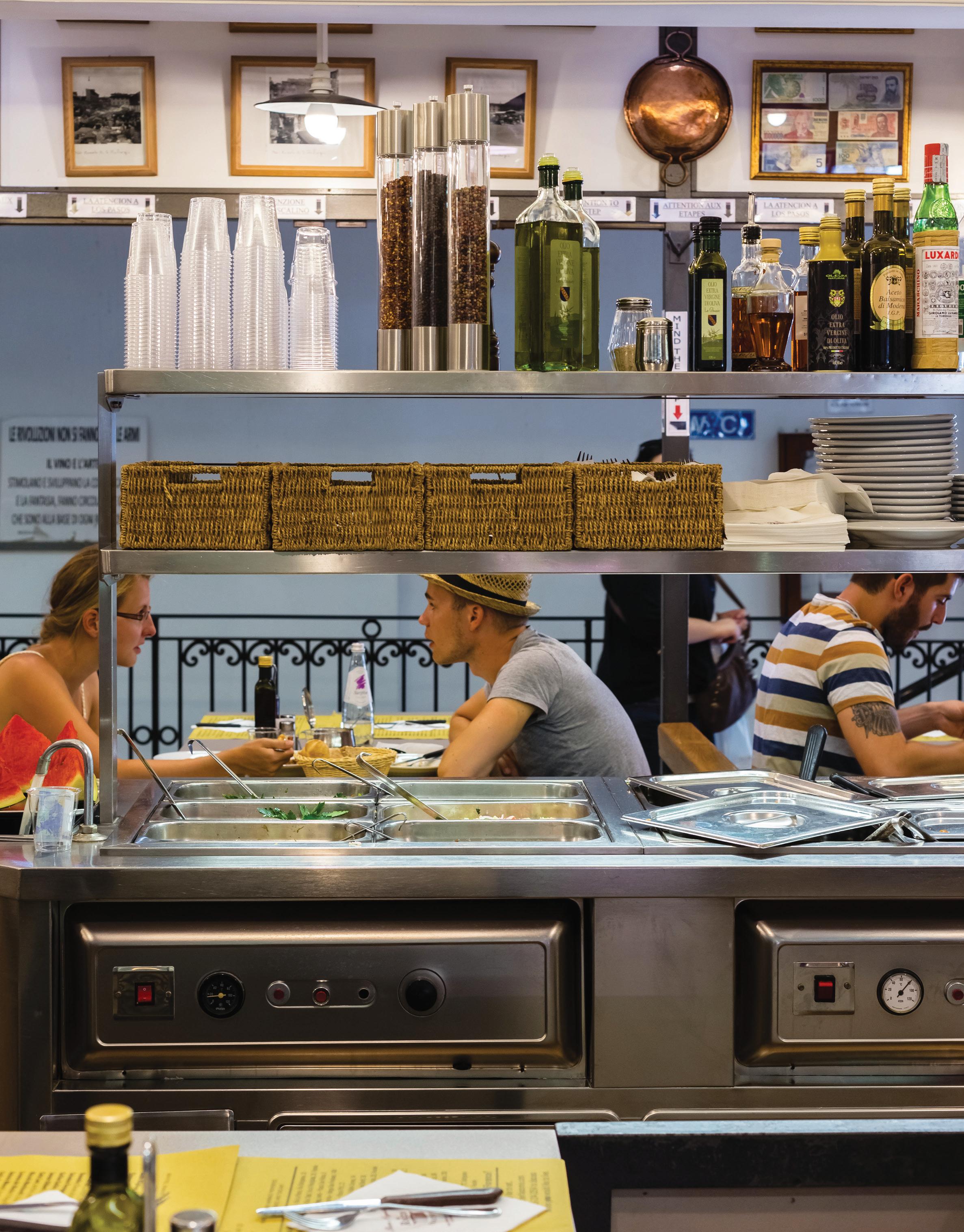
pulls away from the hook.
In the last 5 minutes, add the raisins and mix long enough to incorporate them. Transfer the dough to a bowl greased with olive oil. Let rest for about 15 minutes in a tepid area, such as inside a closed oven with the light turned on. After the dough has rested, divide it into equal pieces weighing 60 grams each. Next form the round buns. This step is not difficult, but it does require some practice. Using both hands, fold the dough onto itself so that each piece forms a tight ball. Transfer them to two baking sheets lined with baking paper, making sure to leave a good amount of space between them as they will enlarge during cooking.
Beat the egg together with a spoonful of water and carefully brush each bun. Let the buns rise for about 25 minutes.
Cross the buns with two vertical and two horizontal slices across the surface of each, pressing firmly, then repeat the glaze and let them rise again. They should double in size.
Heat the oven to 180°C / 356 °F and cook the buns for about 15 -20 minutes or until they are golden and puffed. Meanwhile, make the syrup by boiling the sugar and water together with the opened vanilla pod for about 10 minutes.
Remove the buns when cooked and brush them with the syrup while still hot, then sprinkle them with small sprigs of rosemary. Let cool. They are best served still slightly warm, but they keep well for 5 to 6 days in a cookie tin or ziplock plastic bag.

Where: Between Via dell’Ariento, Via Sant’Antonino, Via Panicale and Piazza del Mercato Centrale.
When: The ground floor is open from Monday to Friday, 7am to 2pm and Saturday from 7am to 5pm, excluding summer months. The street food section is open every day from 10am to midnight.
Where to eat: Take a seat at one of the small tables at Da Nerbone for a sandwich or dish of lampredotto, or try the lampredotto sandwich at Beatrice Trambusti’s stall in Via dell’Ariento, just across from the market entrance.
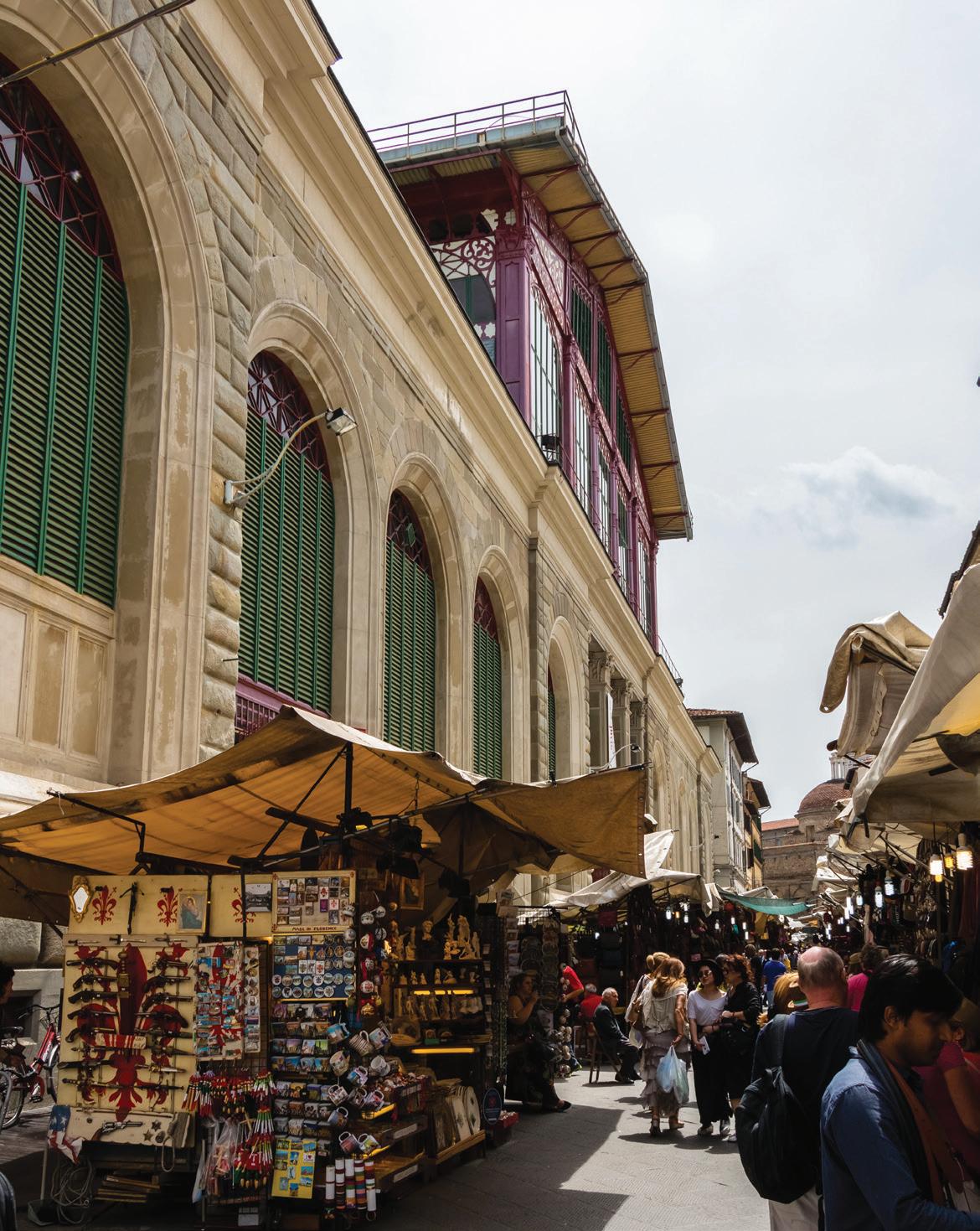

Not to miss: A chat with Luciano Manetti, a Florentine butcher in business for 71 years, or the sliced cold cuts at Pierini.
Outside the market: A stop at the nearby historic perfumery and herbalist shop Officina Profumo Farmaceutica di Santa Maria Novella to pick up some Alchermes, made according to a recipe developed by the then-director, friar Cosimo Bucelli, in 1743.


Justa few minutes from the Duomo, the San Lorenzo Central market is interesting for its architectural merits, having been designed by Giuseppe Mengoni, the architect responsible for the Vittorio Emanuele II shopping arcade in Milan, who took inspiration from the Halles market in Paris. Glass and iron elements lend this building an imposing look, and the large overhead windows allow natural light to enter and fill up the space.
Today, San Lorenzo market is more popular with tourists than Florentines, given its central location so close to the Duomo. It’s worth a visit all the same, not only for its architecture but also for the historical importance it represents, its picturesque stalls and traditional Florentine dishes such as tripe and lampredotto.
A recent restoration has transformed the top floor of the market into an area dedicated to more contemporary concepts, such as street food, together with a cooking school, and vendors of pizza, fresh pasta, meat and fish. Choose what you like to eat and take a seat at one of the stools or at one of the small tables in the center of the space.
The heart of the market, however, is the ground floor, with its butchers, fruit and vegetable vendors, deli and tripe counters, bakers and fishmongers—all set up in their specific areas based on the natural ventilation of the building. Here you’ll also find offal, a favorite among Florentines, from cheek and stomach and lungs to testicles, tails, paws, tripe, tendons, udders and ventricino*, cured pork fat encased in stomach lining or intestine.
Next to the fruit, vegetables, fish and meat areas is Pierini’s counter, a popular lunch spot among Florentines. One look at the counter is enough to appreciate the wide selection of cold cuts, prosciutto, salamis and cheeses. Most of the products on offer here are Tuscan, coming from small farms and butchers. For a while now they’ve been offering hot dishes like pappa al pomodoro and ribollita, in addition to the nearly 40 types of sauces on display for pasta and crostini, all made with pride by the proprietors.
In his book Florentine Cuisine, Aldo Santini writes, “Tripe is the specialty dish of true Florentines, economical and excellent.” For centuries, tripe vendors and their counters have brought warmth and flavor to Florence’s working-class neighborhoods. Locating a recipe for Florentine tripe, however, is a challenging task, given that each family, restaurant and tripe vendor jealously guards the ingredients and measurements.
Should the mince start with onion, carrot and celery? Or only onion? Or garlic? Does one use tomato pureé or peeled whole tomatoes? Ask any Florentine, and he or she will swear that their family’s version is the most authentic. Moving outside from Florence, the variations only increase, with the Sienese version, for example, calling for meat sauce.
Tripe is not always a favorite. In my family, however, I and my mother adore tripe. I’ve tried several different versions, each very nice. But as often happens, I’ve settled on what I considered the best recipe, by leaving out the extra or unnecessary ingredients.
Ingredients for 4 people
800 g tripe
extra virgin olive oil
1 red onions
500 g peeled tomatoes
1 tablespoon tomato paste
salt
red chili powder
grated Parmesan cheese
Ask your butcher for both the reticulum and the rumen of the tripe, as these parts have distinct textures and both are necessary to balance a well made dish of tripe.
Wash the tripe under running water. Parboil it in a large pot with a wedge of lemon for about 5 minutes. Drain and let cool. Cut the tripe into strips about 1 centimeter (about half an inch) wide. The strips don’t need to be exactly the same, but they shouldn’t be too thick.
Thinly slice the onion and sauté them in a tablespoon of oil. When they turn translucent add the peeled tomatoes, smash them with a fork and let cook on medium heat for 15 minutes. Adjust for salt and (optional) season with red chilli.
Add the tripe and the tomato paste and cook on low heat for an hour, adding small amounts of hot water occasionally if the mixture becomes dry. The tripe should be well seasoned and tender, with enough sauce to enjoy dipping some bread in, yet not too liquid. Serve the tripe with plenty of fresh bread and a few spoonfuls of grated Parmesan cheese, if you like. Alternatively, serve the tripe in rolls which have had the soft insides removed, as you would with lampredotto. If you make sandwiches, use kaiser rolls or rosetta rolls.
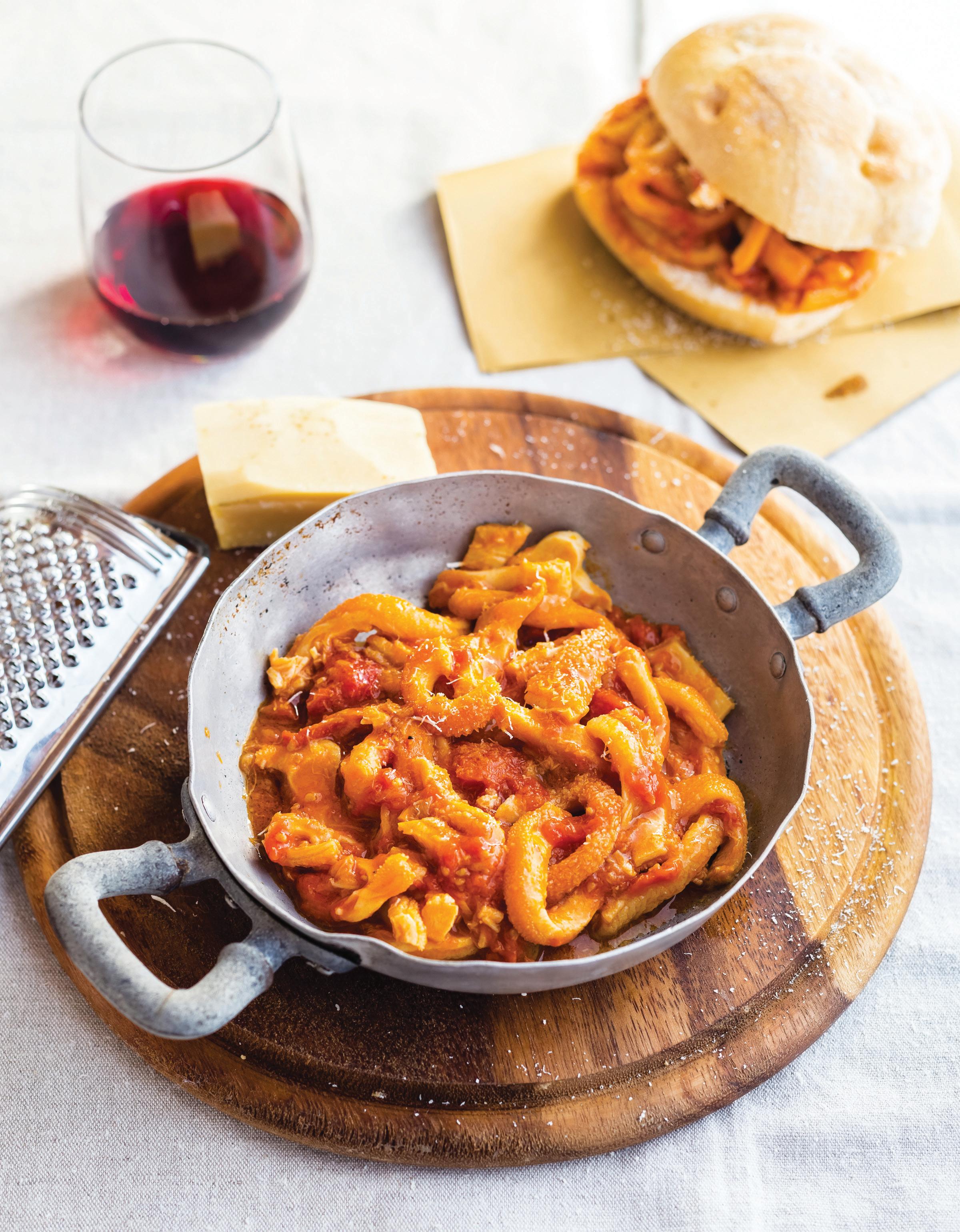

I tasted lampredotto for the first time in Florence. It’s not easy to find, actually,, at either market counters nor home kitchens outside of Florence.
Considered Florence’s most characteristic dish, it is matched in reputation only by bistecca fiorentina, (Florentine t-bone steak) and pappa al pomodoro.
If you are eager to spend time among true Florentines, get in line at one of the numerous tripe counters and mix with the locals, tourists, workers and students. Lampredotto is an institution, a rite whose phases must be properly observed. First, the roll is dipped into the lampredotto’s cooking juices. It can be eaten simply as is or with the addition of salt, pepper, green sauce or spicy sauce. Lampredotto is surprisingly delicate, despite its somewhat unconvincing appearance. How to eat lampredotto? Standing, while leaning slightly forward with the legs apart as to avoid dripping oil on one’s clothing. If that happens, not to worry.. This is the official Florentine stamp of approval.
In addition to sandwiches, Florentines have come up with countless ways to enjoy lampredotto, from risotto to meatballs (famous at the restaurant Il Magazzino in Piazza della Passera. You can hardly tell they are made from lampredotto!).
Marco and Lorella, who have a ground floor stall at the central market, advised me to try it ‘in zimino’, referring to a traditional Tuscan dish in which cuttlefish are cooked in a dense sauce that features leafy greens. In zimino requires garlic, some cherry tomatoes, plenty of herbs, chard or spinach. Not surprisingly, the origins of the term are uncertain. For some it derives from the Arabic “sàmin”, meaning “herb sauce.”
Ingredients for 4 people
500 g lampredotto
1 carrot
1 red onion
1 celery stalk
1 small bunch fresh parsley
salt
4 tablespoons extra virgin olive oil
3 garlic cloves
4 ripe datterini tomatoes
250 g chard, cooked and thoroughly drained of liquid
salt
black pepper
Rinse the lampredotto in running water and place it in a large pot with the carrot, celery, parsley and onion. Fill the pot with water, add a generous pinch of salt and bring the liquid to a boil. Cook the lampredotto in its broth for around 45 minutes. Remove from the heat and let cool in the pot.
To make the in zimino sauce, first slice the lampredotto into thin strips.
Finely chop the garlic and brown in olive oil in a pan, then add the lampredotto. Cut the tomatoes into small pieces and finely chop the chard, and add both to the pan.
Adjust the salt and pepper and let cook on high heat until the water has reduced. About 20 minutes should suffice.
Serve the lampredotto in zimino with large slices of bread, seasoned with additional pepper and grated Parmesan.

Where: Piazza Santo Spirito, Florence.
When: The third Sunday of every month, excluding August.
Not to miss: The ricotta necci made by Signora Lucia, the herbs grown at La Penta farm, the raw honey and extracts made by Gigliola and Giovanni, the basil pesto from Roberta together with Antico Colle Fiorito’s Tuscan pecorino cheese.
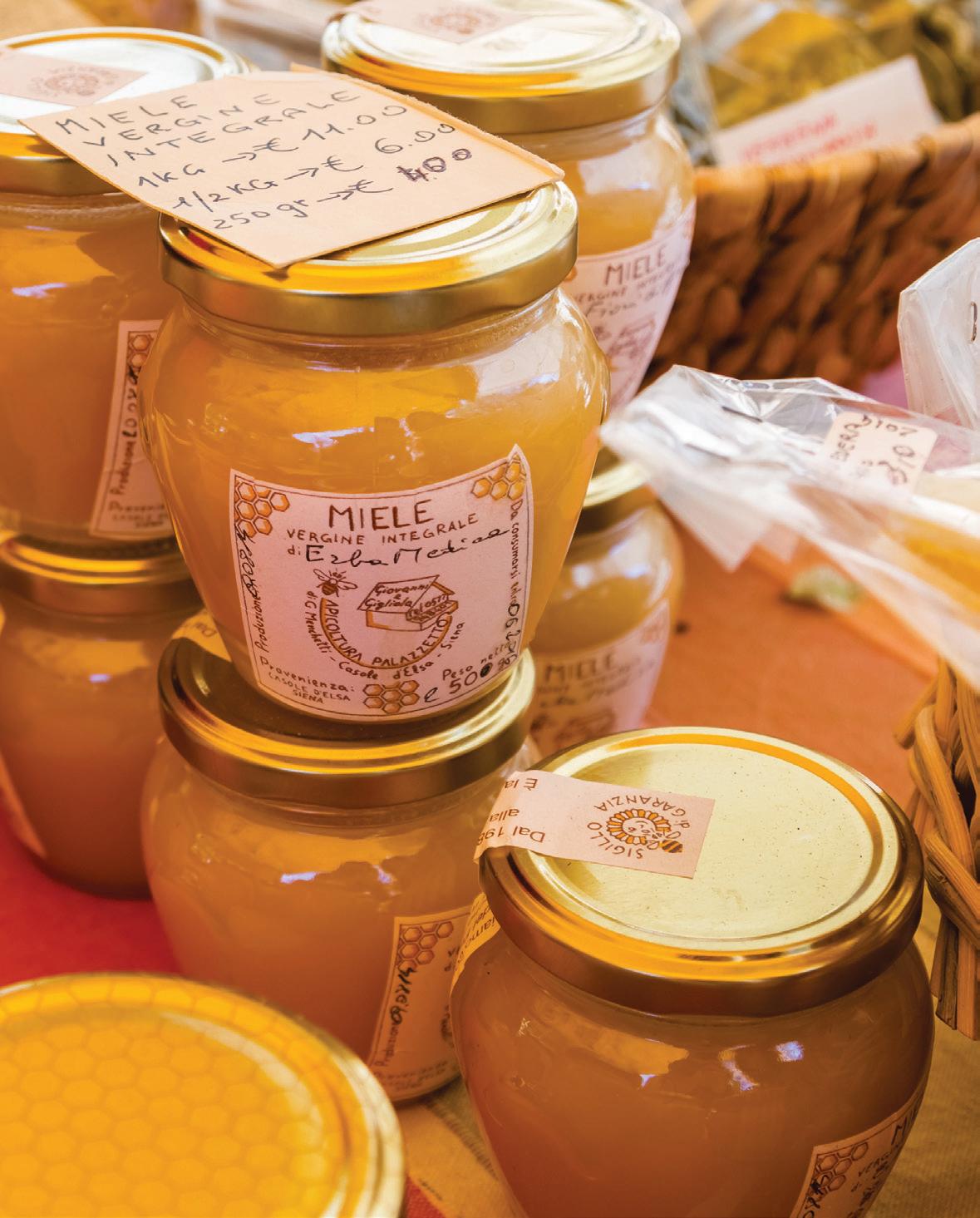
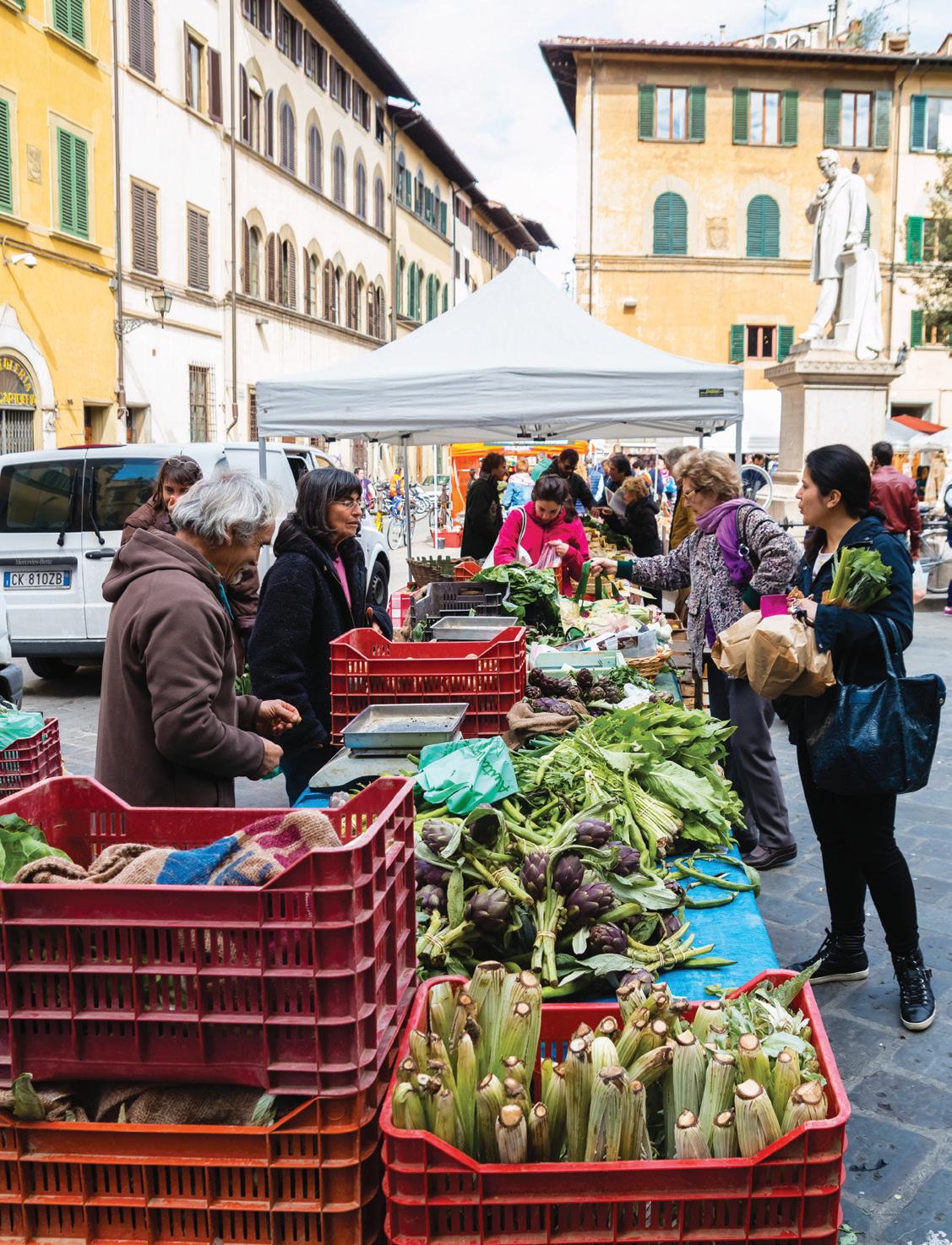
Where to eat: Sabatino, a traditional and unpretentious Florentine trattoria in the San Frediano district, or La Casalinga in Santo Spirito. For a lovely gelato, head to Piazza Tasso and find La Sorbettiera.

Florence is divided into districts, each with its own distinct and recognizable feel. Whereas the areas most known to tourists are those around the Duomo and Piazza della Signoria, crossing the Arno river takes you to the quieter and more authentic area of Florence known as the Oltrarno, and its districts San Frediano and Santo Spirito. Here you still find artisan workshops and locals who greet each other on the street. Everyone knows each other, and locals here feel they come from a separate town within the city of Florence.
In Piazza Santo Spirito, otherwise known simply as Santo Spirito, every third Sunday sees the farmer’s market, offering organic and biodynamic products.
The scene is rowdy, lively, spontaneous. Here everyone is a farmer or producer, bringing the very best of their seasonal crops. They’ve all known each for years and lend each other a hand when needed. Everyone brings along something they’ve made to share come lunch, eaten together at a long table.
Imagine the perfect farmer’s market. Santo Spirito’s is not far off the idea you’ve formed in your head. Here you’ll find stone ground flours, honey, organic fruits and vegetables, bread and sweets made with marmalade, preserves from Antico Colle Fiorito, cheeses, organic wines, and even plants to start up your own garden.
A special mention must go to the necci (crepes made with chestnut flour) made by Signora Lucia of the farm L’Alberaccio, for thirty years a regular fixture at the Fierucola market in Piazza Santissima Annunziata. Today she sells her necci in Santo Spirito as well. Lucia farms her own estate of about 10 hectares, including a wooded area. A small part of her enterprise is growing garden vegetables, apples and pears. But chestnuts make up most of her production.
The chestnuts are dried in the traditional way, then ground at a certified stone mill. With the resulting flour, Lucia makes her necci with ricotta. Stop by to chat with her and her grandson, and observe what attention her husband Giorgio pays to preparing their snack.